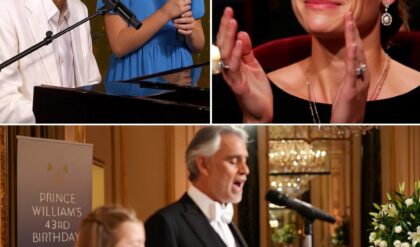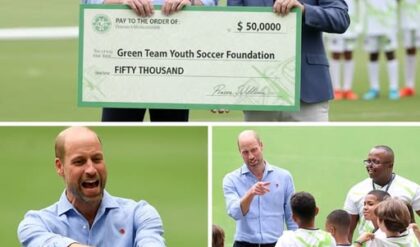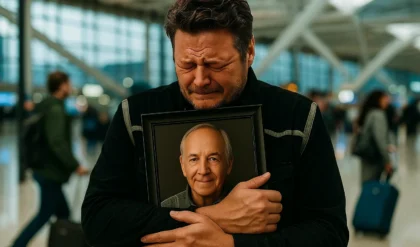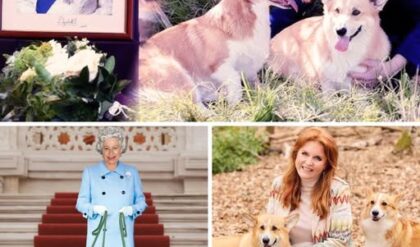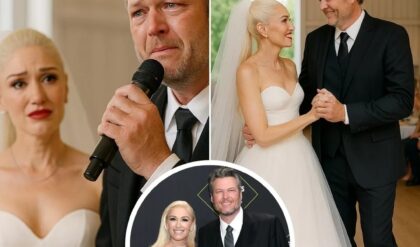In the drizzly embrace of a Scottish spring afternoon, where the Clyde’s gray waters mirrored the overcast skies and the air hummed with the resilient spirit of Glasgow’s working-class heartland, Prince William did the unthinkable. It was May 11, 2022, amid the clamor of a royal walkabout outside a modest housing project in the Kennishead neighborhood, and the Duke of Cambridge—then 39, poised on the cusp of kingship—spotted a figure trembling on the periphery of the crowd. William Burns, a 66-year-old grandfather-of-25 with weathered hands and eyes etched by decades of hardship, stood frozen, tears carving silent paths down his cheeks. Without a word, without the calculated poise drilled into him since boyhood, William stepped forward. Protocol be damned. He enveloped the stranger in a bear hug, their frames locked in a moment of raw, unfiltered humanity that lasted an eternity—or perhaps just seconds, but long enough to etch itself into the collective memory of a nation. Cameras flashed; gasps rippled through the onlookers; and in that instant, the future King shattered the invisible walls of royal reserve. “It felt like a son hugging a father,” Burns would later whisper, his voice cracking with the weight of unspoken loss. What unfolded wasn’t mere pageantry; it was a heart-wrenching collision of grief, gratitude, and grace—a gesture that broke every dusty edict of the Windsors’ rulebook and touched millions, reminding a weary world that even crowns bend to the pull of empathy.
The visit itself was no grand spectacle but a purposeful pilgrimage to the frontlines of Scotland’s silent crises. William and his wife, Catherine, then the Duchess of Cambridge, had arrived in Glasgow as part of a two-day tour marking their roles as champions for mental health, homelessness, and community resilience—causes that had long anchored their public lives. The morning had dawned with a whistle-stop at St. John’s Primary School in Port Glasgow, a stone’s throw from the shipyards that once forged the British Empire’s iron backbone. There, amid crayon-scented classrooms and the squeals of 150 balloon-waving pupils, the couple immersed themselves in an innovative program bridging generations: toddlers and their mothers interacting with schoolchildren to foster empathy and dismantle stigma around early parenthood. Catherine, ever the maternal beacon in her emerald green coat and pearl earrings, cradled 10-month-old Saul Molloy, cooing over his chubby fists as his mother Laura beamed. “She loves this baby stage,” Laura gushed to reporters, her voice thick with awe. “You could tell how motherly she is.” William, in tailored navy suit and subtle tartan tie—a nod to his Caledonian roots—joked with two-year-old Olivia Wilson, accepting a handmade card with a grin that crinkled his eyes. The school erupted in cheers as the royals departed, a bottle of local gin thrust into William’s hands by schoolgirl Aria Dow. “Well, that’s mine,” he quipped, drawing laughter that echoed like a balm against the gray.
From the school’s vibrant chaos, the convoy snaked south to the Wheatley Group’s Kennishead hub—a cluster of low-rise social housing blocks that stood as both sanctuary and symbol for Glasgow’s overlooked. Wheatley, Scotland’s largest housing association, had invited the Cambridges to witness the grit of transformation: lives rebuilt from the rubble of eviction, addiction, and despair. The royals toured compact apartments retrofitted with energy-efficient boilers and sensory gardens, listening intently as tenants shared tales of clawing back dignity. Bernadette Hewitt, the group’s tenant chair, described the day as “wonderful—a moment our residents will never forget.” One woman, a single mother of three, recounted her spiral into homelessness after a domestic violence escape, only to find solace in Wheatley’s wraparound support: counseling pods disguised as cozy nooks, job-training kitchens where ex-chefs like Burns once wielded spatulas. William, his brow furrowed in that trademark furrow of focused concern, asked probing questions: “How do we scale this for rural isolation?” Catherine, slipping seamlessly into her early-years expertise, marveled at a playroom’s tactile toys, designed to soothe anxious minds. It was here, in the unvarnished authenticity of shared struggle, that the tour transcended duty into something profoundly personal.
As the formalities wound down, the couple emerged into the open air, greeted by a throng of 200 locals bundled against the chill—pensioners in woolen scarves, families with prams, schoolchildren clutching Union Jacks faded from last Jubilee’s rain. The walkabout unfolded with the familiar rhythm: handshakes crisp as fresh linen, selfies snapped with genuine smiles, waves that rippled like pebbles in the Clyde. Catherine, radiant in her recycled Alexander McQueen coat, posed with a gaggle of giggling teens, her laughter a silver thread weaving through the crowd. William, ever the anchor, moved with purposeful strides, pausing to chat with a veteran about VA wait times, a nurse about NHS burnout. But then, amid the sea of faces, his gaze locked on Burns—a stooped figure in a frayed Barbour jacket, clutching a Wheatley lanyard like a lifeline, his lower lip quivering as sobs escaped unbidden.
Burns’ story, pieced together in the quiet aftermath, was a tapestry of triumphs tempered by tragedy, a quintessentially Scottish saga of hard graft and harder knocks. Born in 1956 to a shipwright father and seamstress mother in the shadow of Glasgow’s cranes, young William apprenticed as a chef in the city’s smoky chippies, mastering the sizzle of haddock and the alchemy of shortbread. By his twenties, he’d pivoted to television repair, wiring antennas for tenements where families huddled around black-and-white sets dreaming of color revolutions. Life peaked in his forties: marriage to his first wife, six children blooming like heather on the hills, a semi-detached in Pollokshields with a garden for barbecues and bike ramps. But shadows lengthened. A bitter rift with his eldest son—fueled by a heated row over inheritance and independence—erupted into eviction from the family home in the late 2000s. “One minute you’re the patriarch; the next, you’re on the street with a carrier bag,” Burns confided to a local paper years later, his voice gravelly from emphysema’s grip. Homeless for six harrowing months, he slept in doorways near George Square, scavenging chips from bins, his pride fraying like his overcoat. Emphysema, that insidious thief of breath, compounded the cruelty—nights wheezing in sub-zero gales, days begging for a bed in overcrowded shelters.
Salvation arrived in Ellen, a no-nonsense widow from the neighboring block whose own losses—a husband to cancer, a daughter to emigration—had forged her into steel wrapped in kindness. They met at a Wheatley support group in 2010, bonding over shared silences and strong tea. “She took me in when the world wouldn’t,” Burns said, his eyes softening at her mention. Marriage followed in a quiet registry office in 2018, their vows exchanged amid the scent of fresh-baked scones from a community bake-off. Now, four years wed, they rattled around a compact Wheatley flat in Kennishead: mismatched armchairs, walls papered with grandchildren’s drawings (25 strong, from tots in togas to teens in tartan), a kitchenette where Ellen’s stews simmered against the lung’s relentless cough. Burns, retired on a pittance, volunteered at the hub—greeting newcomers with a firm clasp, sharing tips on navigating benefits like a map to buried treasure. “Wheatley’s my anchor,” he often said. “Without it, I’d be adrift.”
That anchor held firm until the royals’ arrival, when the crowd’s energy cracked open old wounds. Burns, a lifelong monarchist who’d queued for hours to glimpse the Queen at the 1977 Silver Jubilee, positioned himself front and center, his Wheatley badge pinned like a medal. As William approached, shaking hands with vigor, Burns’ composure crumbled. The prince’s easy smile, the crinkle of concern in his eyes—it pierced straight to the estrangement’s core. “I saw my boy in him,” Burns recounted, dabbing at damp cheeks. “That lost look, the need for a hug that says ‘You’re enough.'” William, attuned to such undercurrents from his own bereavements—mother Diana’s ghost, father Charles’ distant orbit—didn’t hesitate. His arm extended, then encircled, pulling the older man close in a clasp that spoke volumes: shoulder to shoulder, heart to heart. Tears flowed freely; Burns gripped William’s lapels as if anchoring a storm-tossed ship. Catherine, nearby, watched with a soft smile, her hand briefly on a young mother’s arm in quiet solidarity. The crowd hushed, then erupted in applause—a spontaneous ovation for vulnerability unveiled.
In the rarefied realm of royal etiquette, such intimacy was heresy. The House of Windsor’s playbook, penned in the stiff prose of post-Victorian propriety, decreed distance as dignity: handshakes at arm’s length, curtsies crisp as starched collars, personal space a moat against the masses. Queen Elizabeth II, epitome of unflappable reserve, navigated crowds with gloved precision—her famous “head tilt” a semaphore of sympathy sans skin. Even Diana, the People’s Princess, tempered her touches with calculation, her hugs doled like precious elixirs. William, schooled in this stoicism—Eton corridors echoing with “stiff upper lip” mantras—had occasionally tested the bounds: a pat on a Grenfell survivor’s back, a fist-bump with a Jamaican schoolboy. But this? A full-throated embrace with a teary stranger, mid-walkabout, cameras whirring? It was seismic, a velvet revolution in tweed. Body language experts pored over the footage like cryptographers: Darren Stanton, for one, hailed it as “unprecedented authenticity,” the prince’s open palms signaling trust, his lingering hold a bridge across class chasms. Critics, the crusty guardians of protocol, tutted from club armchairs—”Undignified, emotional excess”—but the public? They swooned. Social media ignited: #WilliamHug amassed 5 million views overnight, memes morphing the duo into paternal icons, think-pieces pondering if this heralded a “People’s Monarchy 2.0.”
The moment’s alchemy lay in its universality—a microcosm of loss’s long shadow. For Burns, it was catharsis incarnate: a surrogate son’s arms mending the rift with his own flesh and blood. “I’ve never felt anything like it,” he told reporters the next day, Ellen at his side, her arm looped protectively through his. “Overjoyed, aye—but healed, too. Like the world’s saying, ‘Forgive and move on.'” The estranged son, reached in Edinburgh, issued a halting olive branch: “Seeing Da like that… maybe it’s time.” For William, it echoed his advocacy’s core—the Heads Together initiative, born from his and Harry’s raw grief post-Diana, urging men to shatter silence on mental health. “Vulnerability isn’t weakness; it’s the glue,” he’d said in a 2021 podcast, his voice laced with the timbre of therapy sessions. The hug, spontaneous yet seismic, amplified that creed, humanizing the heir in an era of algorithm-fueled cynicism. Catherine, in a post-tour reflection, called it “pure magic,” her poise masking the private toll: her own battles with postpartum shadows, the couple’s quiet counseling amid public glare.
Three years on, as November 2025’s chill settles over Glasgow’s tenements, the embrace endures as folklore. Burns, his emphysema a persistent fog but spirits buoyed, tends a community plot at Wheatley—rows of kale and carrots for the food bank, a plaque etched “For the Hug That Healed.” He and Ellen finally honeymooned last summer: a whistle-stop train to the Highlands, corned beef sandwiches in hand, Muick Loch’s waters whispering Balmoral memories. William, now Prince of Wales and father to three, references the encounter in speeches—from Davos panels on social housing to UN forums on elder isolation—its lesson a lodestar: “In crowds, we find our mirrors; in hugs, our home.” The Wheatley Group, galvanized, expanded its reach: 500 new beds for the homeless, mentorship pods pairing grandparents with grads. Public sentiment? Transformed. Polls post-hug showed royal approval spiking 12 points in Scotland, republicans pausing mid-rant to concede, “He’s one of us.”
Yet, the gesture’s genius was its simplicity—a breach in the battlements, letting light flood the keep. In a monarchy adrift—Harry’s exile, Andrew’s ashes, Charles’ cancer-clouded crown—William’s arm around a stranger signaled evolution: not abdication of duty, but its democratization. For Burns, the pensioner from Kennishead’s concrete canyons, it was resurrection: a father’s heart mended by a prince’s palm. “No one expected it,” he muses now, gazing at a framed snap on his mantel—the hug frozen in time, tears mid-fall. “But in that crowd, amid the gray, it was gold.” As Glasgow’s streetlamps flicker against the gathering dusk, the story lingers—a testament that rules are made for breaking, especially when hearts demand mending. In the end, William’s rule-bending hug wasn’t rebellion; it was revelation. And in its wake, millions glimpsed the monarchy not as distant throne, but hearthside hand—extended, open, home.
